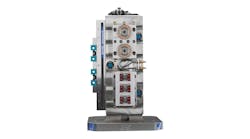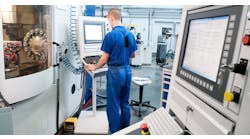Sustainability is vital for a healthy planet – according to the general consensus of individuals and organizations – and increasing numbers of both are seeking ways to reduce waste, increase efficiency, and minimize energy consumption. That includes manufacturing enterprises. Currently, manufacturing operations consume about 33% of the global energy supply, so it’s important to create a positive trend.
In addition to helping the environment, focusing on sustainability can save on operating costs and improve your organization's reputation. There are many ways to reduce energy consumption and become more eco-friendly.
Why sustainability?
There are numerous reasons to jump on the eco-friendly bandwagon. One of these is the potential cost savings via a reduction in operating costs. If you have fewer machines running, or they're running more efficiently, you'll save energy costs. Sustainable manufacturing can often save millions of dollars.
When you have a well-oiled machine that's clean and sustainable, you also have a good chance of long-term business viability because you won't go through resources as quickly.
Then there's the opportunity to improve your reputation. If a vendor uses the items you produce and can claim that their manufacturer uses sustainable practices, customers may take notice. Many consumers are looking to source from sustainable companies, so following the public's values could also help you stay competitive in a potentially highly saturated environment. Your employees may also be happier knowing they work for an organization that cares about the environment and is truly making a difference.
What is manufacturing waste?
It's also necessary to realize that manufacturing waste can take many forms. Some are obvious, like the energy wasted if the factory lights are on all night even if no one is there, or the water wasted if a system springs a leak.
However, there are also other forms of waste to consider, such as overproduction. If you're not on top of production and inventory, and you're making more than is necessary, then resources are being wasted just to put unnecessary items in storage. There's also waste associated with transportation. Are you wasting fuel and electricity by moving things several times instead of having a streamlined way of transporting them from point A to B? Forklifts may consume 3 to 4 liters of diesel fuel per hour. When diesel is burned, it produces harmful emissions, and you can cut down on that with more efficient routes.
Don’t forget about the waste associated with waiting and inactivity. If you have machines idling for minutes at a time without a purpose, you're likely burning through unnecessary energy.
An audit can identify the types of waste occurring in your operation.
Learn about wasted energy
There are many ways to reduce waste in your organization. Before you start, first conduct a waste and energy audit. An expert will look at all of your systems and provide comprehensive notes for how your operation can reduce waste, improve machines and systems, and create more opportunities to recycle.
You can also measure the waste your organization produces by looking at and weighing how much is thrown out every day. Look through that to see how much might be recycled. Once you set up a recycling program, measure the waste you’ve produced again to determine if you’re making headway.
If you can tell that major adjustments need to be made, the next step is to create a clear and actionable waste management strategy. This routine should include goals for how much waste you hope to eliminate and a way to determine if you've met those goals. Remember that waste elimination strategies don't have to be complicated. They could be as simple as starting a recycling program in the cafeteria or going paperless.
It's essential that you get your entire team involved in the strategy and ensure that everyone is on board and following the guidelines. One way to encourage them to follow along is to implement incentives and recognition programs. If a particular employee or team can find a way to reduce waste in their department, announce their success company-wide so more people are likely to want to do their part.
Automation may be the answer
A big part of your waste management strategy may include automation. There are countless benefits to automation, especially in machining and manufacturing. One of them is the ability to streamline your methods. You may have several employees working on one process, but one of them may be completing a monotonous task that a computer program could do instead. Automate the task, and you can assign that employee to a more important role in the organization.
Do it right, and automation can also help the environment. When you eliminate unnecessary steps in your manufacturing processes, you'll also eliminate unnecessary energy usage. Unless you're using sustainable energy sources, the electricity is probably produced by burning fossil fuels, which results in greenhouse gas emissions that harm the atmosphere. Automate the systems so fewer machines are operating, and you're already helping the planet.
Automation can help the environment in other ways you may not have considered. For instance, by automating the thermostat to change the interior temperature based on weather patterns or occupancy in your factory, you'll ensure HVAC systems don't have to run longer than necessary. You could automate your water management systems to automatically detect leaks and control flow so you cut down on water waste. Check all your systems for vulnerabilities and see if automation can help you get to a better place.
There are many warehouse processes that may benefit from automation, including programming robots to stack, paint, weld, or apply labels. Automation can help with inventory management by keeping a constant eye on what is coming in and going out.
Update the warehouse
There are also many opportunities to reduce waste and energy consumption by looking for sustainable alternatives for your physical plant – including solar panels for capturing solar energy instead of relying on the electric grid. Other forms of sustainable energy, such as wind power, may be worth considering too. Research what opportunities may be available in your region.
When it comes to sustainable manufacturing, even a small change can make a big difference. Update all of the lighting fixtures in your plant and swap out incandescent bulbs for LEDs that will last longer and cost less. Another idea is to install low-flow faucets in bathrooms and break rooms to reduce water waste.
While you’re searching for sustainable solutions, you could also look at product packaging. Consider eco-friendly materials, which may include plant-based packing peanuts or packaging tape made from corn starch. You can take the idea even further by packaging more items in boxes so you use fewer materials overall.
While finding updates can help to eliminate waste, so can maintaining the machinery in which you are invested. The key here is to set up a preventive maintenance schedule. You must ensure your machinery is in good repair to avoid unexpected breakdowns. The overtime and energy necessary to get back on track after a significant disruption can incur a lot of wasted energy.
And you may need new parts that will need to be manufactured and shipped to you, which creates waste. Set up a regular maintenance routine, and you can avoid a lot of unnecessary stress and help the planet simultaneously.
There are numerous sustainable practices to consider adopting at machining and manufacturing operations, and all have potential investment value. Find ways to streamline your processes, and you'll make the world a better place while you bring your plant to a new level of sustainability.
Ainsley Lawrence is a freelance writer and editor. Her most recent contribution is Unlocking the Power of Data Analytics.








